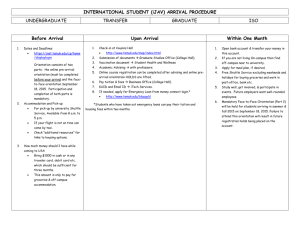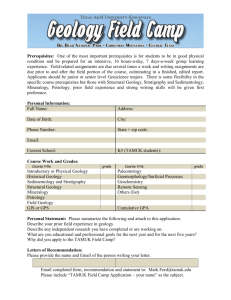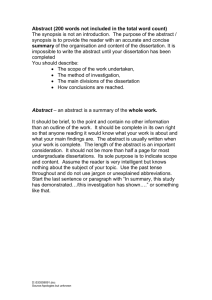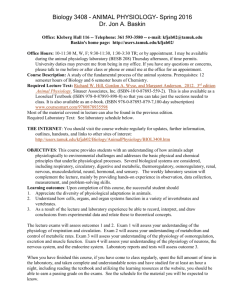Dissertation Proposal - research
advertisement
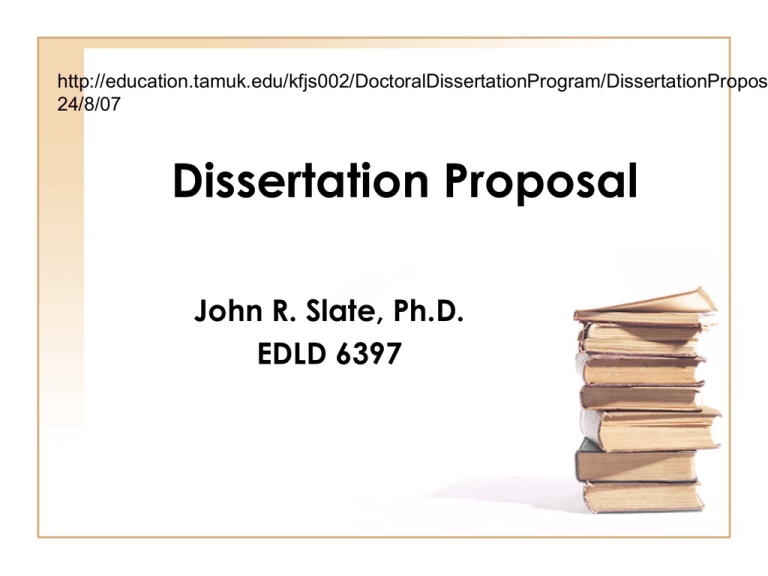
http://education.tamuk.edu/kfjs002/DoctoralDissertationProgram/DissertationPropos 24/8/07 Dissertation Proposal John R. Slate, Ph.D. EDLD 6397 • Taken from Dissertation Guidelines WORD document Dr. Stallone Brown’s website. Contents and Format • The outline for the formal Dissertation Proposal follows. Not all of the sections outlined here may be appropriate for all dissertations. Consult with your chair if you have questions about whether or not to include a particular section in your work. *Generally (except for introductions, summaries, and literature review), proposals are written in future tense, explaining what the researcher “will” do. Verb Tense • *Generally (except for introductions, summaries, and literature review), proposals are written in future tense, explaining what the researcher “will” do. FRONT MATTER • Title Page • Approval Page • Abstract (maximum of 350 words; written in future tense-optional for proposal) FRONT MATTER (cont.) • Table of Contents • List of Tables • List of Figures CHAPTER I INTRODUCTION • Introduction (Introducing the topic of study—2 to 3 pages) • Here you set the stage for the reader to read further. CHAPTER I INTRODUCTION • Statement of the Problem (basic difficulty - area of concern, felt need and goal to be achieved) • Make your case here that this is a relevant issue – one that begs to be addressed. CHAPTER I INTRODUCTION • Purpose of the Study (goal oriented-emphasizing practical outcomes that “may” occur). • May not be “So I can graduate.” • What do you hope/anticipate being able to do with the results of your study? CHAPTER I INTRODUCTION • Research Questions (to be answered or investigated) • May be quantitative • May be qualitative • May have both types present • Must be answerable through data collection and analysis CHAPTER I INTRODUCTION • Research Hypotheses (not null) • I prefer having null first, followed by the research hypothesis for each. • Note that hypotheses are only relevant for quantitative research questions. CHAPTER I INTRODUCTION • Significance of the Study (relevance, need—may overlap with the statement of problem) • You respond to this as if somebody said about your study, “So, what?” CHAPTER I INTRODUCTION • Assumptions (postulates) • What will you have to assume to conduct your study? If survey questions, that respondents will answer truthfully, etc. CHAPTER I INTRODUCTION • Limitations and Delimitations of the Study • A limitation is a factor that may affect the study but is not under your control such as a lack of generalizability. CHAPTER I INTRODUCTION • A delimitation is a factor that is under your control. You might choose to look only at teachers in a particular state or county. CHAPTER I INTRODUCTION • Definition of Terms (largely conceptual here-with citations; operational definitions may follow in Methodology Chapter). • Use a citation for each term you define. Define all jargon and unfamiliar terms. When in doubt, define. CHAPTER I INTRODUCTION • Organization of the Study (outline remainder of the proposal in narrative form) • Last section of Chapter I. CHAPTER II REVIEW OF THE LITERATURE • Introduction (organization of the chapter – overview). • I like to have students tell the reader each subheading that will be discussed, followed by “A summary will conclude this section.” CHAPTER II REVIEW OF THE LITERATURE • Historical Background/Overview (overview of the theory and research literature) CHAPTER II REVIEW OF THE LITERATURE • The theory/research specific to the topic (sections/subsections should match questions). CHAPTER II REVIEW OF THE LITERATURE • Review of Literature Summary (what is known and unknown about the topic) CHAPTER II REVIEW OF THE LITERATURE • Contribution of the Study (what this study will add to the field) CHAPTER II REVIEW OF THE LITERATURE • Literature review is an intensive, extensive, and exhaustive search. • Empirical research articles best. • Primary sources critical. • Historical context important. CHAPTER III METHODOLOGY • Introduction (organization of the chapter – overview) CHAPTER III METHODOLOGY • Research Questions (restated here) • Same exact wording as they appeared in Chapter I. CHAPTER III METHODOLOGY • Null Hypotheses (needed for quantitative research questions) • I also like the research hypotheses to reappear here. CHAPTER III METHODOLOGY • Research Methodology (quantitative, qualitative, or mixed) • Reasons why methodology selected is appropriate to address research questions in study. CHAPTER III METHODOLOGY • Research Design (e.g., correlational, comparative, descriptive, etc.—Explain your variables of analysis here). CHAPTER III METHODOLOGY • Population and Sample (Define very specifically the population AND sample) CHAPTER III METHODOLOGY • Instrumentation (tests, measures, observations, scales, and questionnaires) CHAPTER III METHODOLOGY • Procedures (Field, classroom or laboratory e.g., instructions to subjects or distribution of materials; data collection and recording—everything BEFORE analysis) CHAPTER III METHODOLOGY • Data Analysis (statistical analysis or qualitative analysis explained in detail) CHAPTER III METHODOLOGY • Reliability and Validity (here or as a subheading UNDER Instrumentation) CHAPTER III METHODOLOGY • Summary of Methodology BACK MATTER • References (must be in APA format) • Appendices (each Appendix has own title page; IRB in one appendix) • • Vita APA References • http://citationmachine.net/ Sample Proposal Defenses • http://education.tamuk.ed u/kfmns00/Main%20Page/ PPP_ProposalB_Sp%2006.ppt • http://education.tamuk.ed u/kfmns00/Main%20Page/ Dissertation%20Proposal%2 010_04_06.ppt Sample Proposal Defenses • http://education.tamuk.ed u/kfmns00/Main%20Page/ music%20prop.ppt • http://education.tamuk.ed u/kfmns00/Main%20Page/T he%20Impact%20of%20Sc hool%20Culture%20PPP%20 July%2026.ppt Sample Proposal Defenses • http://education.tamuk.ed u/kfmns00/DissertationProposal-wang.ppt • http://education.tamuk.ed u/kfmns00/Main%20Page/ Dissertation%20Proposal%2 04.6.06.ppt

